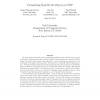Free Online Productivity Tools
i2Speak
i2Symbol
i2OCR
iTex2Img
iWeb2Print
iWeb2Shot
i2Type
iPdf2Split
iPdf2Merge
i2Bopomofo
i2Arabic
i2Style
i2Image
i2PDF
iLatex2Rtf
Sci2ools
PADL
2012
Springer
2012
Springer
Virtualizing Real-World Objects in FRP
We begin with a functional reactive programming (FRP) model in which every program is viewed as a signal function that converts a stream of input values into a stream of output values. We observe that objects in the real world – such as a keyboard or sound card – can be thought of as signal functions as well. This leads us to a radically different approach to I/O – instead of treating real-world objects as being external to the program, we expand the sphere of influence of program execution to include them within the program. We call this virtualizing real-world objects. We explore how even virtual objects, such as GUI widgets, and non-local effects, such as are needed for debugging (using something that we call a “wormhole”) and random number generation, can be handled in the same way. Our methodology may at first seem na¨ıve – one may ask how we prevent a virtualized device from being copied, thus potentially introducing non-determinism as one part of a program com...
Functional Reactive Programming | Gui Widgets | PADL 2012 | Programming Languages | Random Number Generation |
Related Content
| Added | 25 Apr 2012 |
| Updated | 25 Apr 2012 |
| Type | Journal |
| Year | 2012 |
| Where | PADL |
| Authors | Daniel Winograd-Cort, Hai Liu, Paul Hudak |
Comments (0)

